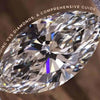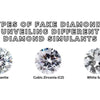
VVS1 vs. VVS2: Exploring the Different Grades of Diamond Clarity
Introduction
Diamonds are undoubtedly one of nature's most beautiful creations. They're symbolic of love, commitment, and special moments. But as any ring planner would tell you, not all diamonds are made equal. One of the key characteristics that differentiates one diamond from another is its clarity. And this is where the terms vvs1 and vvs2 come into play.
The world of diamond grading might seem perplexing, but with a little insight, it doesn't have to be. By understanding the nuances between vvs1 vs vvs2, you're not just purchasing a gem; you're investing in a story, a moment, and a legacy.
Understanding VVS1 Clarity
VVS1 diamonds represent a high clarity grade. The term "VVS" stands for "Very, Very Slightly Included." This means that the diamond has minute inclusions that are difficult for even skilled graders to see under 10x magnification.
So, what sets vvs1 diamonds apart? The position of these inclusions. In VVS1 diamonds, the tiny inclusions are typically located on the pavilion, or the bottom half of the stone. This makes them even more challenging to detect, particularly when set in jewelry.
But clarity isn't just about inclusions. It's about how the overall brilliance and beauty of the diamond are affected. With vvs1 diamonds, you're investing in a gem that's almost as clear as the purest diamonds available. It's a choice that whispers sophistication and an eye for detail.
Exploring VVS2 Clarity
When we talk about diamond clarity, we're discussing the tiny imperfections, known as inclusions and blemishes, that exist in almost all diamonds. These imperfections are nature's way of adding a unique fingerprint to every diamond.
VVS2 diamonds, a subset of the Very Very Slightly Included category, are nearly perfect. When gemologists speak of VVS2 clarity, they mean that there are extremely minute inclusions, so small that even trained eyes have a tough time spotting them under 10x magnification.
Why does this matter, especially for engagement ring planners and wedding planners? Simple. With a VVS2 diamond, you're giving your client the luxury of a nearly flawless diamond without the sky-high price tag of a Flawless or Internally Flawless grade.
Moreover, vvs2 diamonds hold a brilliance that is undiminished by inclusions. This ensures that the sparkle everyone expects from a diamond is front and center, captivating every onlooker.
Evaluating VVS1 vs. VVS2

Now, let's delve a bit deeper into the sibling rivalry - VVS1 vs. VVS2. At a glance, both fall under the Very Very Slightly Included category, making them superior in clarity. But how do they differ?
Location of Inclusions: The primary difference between VVS1 and VVS2 diamonds lies in the position of the inclusions. VVS1 inclusions are typically located on the diamond's pavilion, making them almost invisible from the top. VVS2 inclusions, on the other hand, might be located anywhere in the diamond but are still minuscule.
Visibility: While both these categories have inclusions that are difficult to spot even for professionals, VVS1 diamonds usually have slightly fewer or less visible inclusions than their VVS2 counterparts.
Price Point: Given the slight superiority in clarity, VVS1 diamonds typically command a higher price than VVS2 diamonds. However, this difference can be nominal or more pronounced based on other factors like cut, carat, and color.
For wedding planners, engagement ring planners, or anniversary gift aficionados, understanding this subtle difference is crucial. If budget is a concern, going for a VVS2 diamond might provide better value for money without compromising on the visible clarity. On the other hand, if the goal is to get the best of the best, a VVS1 diamond might be the better choice.
Choosing the Right Clarity Grade
Before you choose a diamond, you must be familiar with the clarity grading system. Clarity is a measure of a diamond's internal and external imperfections, known as inclusions and blemishes, respectively.
Flawless (FL): No inclusions or blemishes under 10x magnification.
Internally Flawless (IF): No inclusions and only blemishes under 10x magnification.
Very, Very Slightly Included (VVS1 and VVS2): Minute inclusions that are tough to spot, even for trained eyes under 10x magnification.
Very Slightly Included (VS1 and VS2): Minor inclusions visible under 10x magnification.
Slightly Included (SI1 and SI2): Inclusions easily seen under 10x magnification.
Included (I1, I2, and I3): Inclusions visible to the naked eye.
For those looking to strike a balance between cost and clarity, VVS diamonds are a stellar choice. But what's the real difference between VVS1 and VVS2?
Tips for Buying VVS Diamonds
- Understand the difference between VVS1 and VVS2:
The primary difference between VVS1 and VVS2 is the location, size, and nature of their inclusions. VVS1 inclusions are typically on the bottom half of the diamond, making them less visible, while VVS2 inclusions are usually found on the top half. However, to the average onlooker, this difference is nearly indiscernible.
- Opt for a Trusted Jeweler:
When buying diamonds, especially those of VVS clarity, it's essential to trust the seller. Ensure they provide a certificate from a reputable grading organization detailing the diamond's specifications.
- Consider the Shape and Setting:
While VVS diamonds possess exceptional clarity, the shape and setting of the diamond can either enhance or detract from its beauty. For instance, an intricate setting might overshadow the diamond's clarity, while a solitaire setting can highlight it.
- Don't Overspend for Unnoticeable Differences:
VVS diamonds offer nearly immaculate clarity, but that doesn't mean you should overspend. Sometimes, the difference between VVS1 and VVS2 is almost negligible, especially to an untrained eye. Choose what fits within your budget and resonates with your heart.
Conclusion
Diamonds are not just chunks of carbon; they are tales of love, commitment, and cherished memories. When picking out a diamond, clarity plays a crucial role in its beauty and value. For those in the know, the difference between VVS1 and VVS2 can influence a purchasing decision. But remember, while technical specifications are essential, the story and emotion behind the diamond are what truly matter.
So, whether you're a wedding planner sourcing the perfect ring for a client's big day, an engagement planner trying to capture the essence of a blossoming love story, or someone looking for that unforgettable anniversary gift, remember: diamonds are forever, but it's the clarity in your choices that make them shine brightest.
FAQ: VVS1 vs. VVS2: Exploring the Different Grades of Diamond Clarity
- What do VVS1 and VVS2 stand for?
VVS1 and VVS2 are clarity grades given to diamonds. Both terms stand for Very, Very Slightly Included. It's a way of determining how many imperfections (called inclusions) a diamond has.
- Are these inclusions visible to the naked eye?
Nope! In both vvs1 diamonds and vvs2 diamonds, inclusions are so minuscule they're typically invisible to the naked eye. Only under 10x magnification can a skilled grader spot these inclusions.
- So, what's the real difference between vvs1 and vvs2?
The primary difference between vvs1 and vvs2 is the location, size, and nature of the inclusions. VVS1 inclusions are typically located on the pavilion, or bottom half of the diamond, making them even harder to detect. VVS2 inclusions might be located anywhere in the diamond but are still incredibly tiny.
- Are VVS diamonds the best on the market?
While VVS diamonds, whether vvs1 diamonds or vvs2 diamonds, are of extremely high clarity, they're not the absolute highest grade. That title goes to "Flawless" diamonds which have no inclusions or blemishes even under 10x magnification.
- For someone planning an engagement or anniversary, which should they choose?
Both grades are exquisite choices! But considering the tiny difference between vvs1 and vvs2, it often comes down to personal preference, budget, and availability. Since the inclusions are nearly impossible to spot without equipment, either grade will look stunning in jewelry.
- Is there a significant price difference between vvs1 and vvs2 diamonds?
While there's usually a price difference, it may not be dramatically significant. The cost depends on other factors like the diamond’s carat, cut, and color.
- Do all jewelers offer both VVS1 and VVS2 diamonds?
Most reputable jewelers offer a range of clarity grades, including both vvs1 and vvs2. However, availability can vary based on their inventory and sourcing practices.
- Can you really see the difference between VVS1 and VVS2 with the naked eye?
For the average person, spotting the difference between vvs1 and vvs2 without magnification is next to impossible. But, as always, the beauty of a diamond goes beyond just its clarity grade.
Leave a comment
Please note, comments must be approved before they are published.









